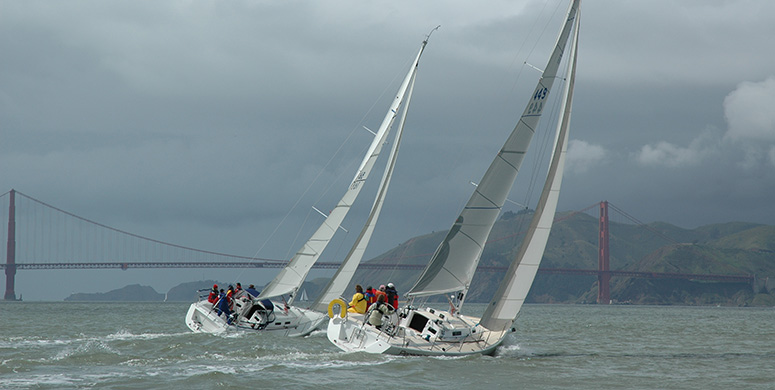Ití's 11 a.m. on a Sunday morning in March and I am scheduled to teach sailing this afternoon. But while I'm sitting here at my computer with a fresh cup of tea, I'm listening to the wind and rain against the window.

National Weather Service changes its forecast from a small craft advisory to a gale warning at around 30 knots of wind. Photo courtesy of OCSC Sailing
By Captain Ray
Published: May, 2016
It’s 11 a.m. on a Sunday morning in March and I am scheduled to teach sailing this afternoon. But while I’m sitting here at my computer with a fresh cup of tea, I’m listening to the wind and rain against the window. I’m wondering whether or not I will be sailing this afternoon in this weather and commiserating with the person who has to make the call to go out or not.
Where I work (OCSC Sailing at the Berkeley Marina), that person is called the duty safety officer. Each day, one member of the management staff is designated as the safety officer, or SO. The SO’s responsibilities include monitoring variables such as wind speed and direction, rainfall, air temperature, etc., and deciding when to call a halt to sailing operations. Most of the time, I don’t envy them the job and I’m glad it’s not me who has to make the call. There are times however, when it’s not dangerous out on the water, just unpleasant. On those occasions, I wish I could make the call: I’d vote to stay in, sit by the fire in the clubroom and just talk about sailing.
We have guidelines, of course. They are based on the experience level of the students and the severity of the conditions. Certainly there is an upper limit where no boats leave the dock. That upper limit (at which point no boats go out and those that are out are required to come in) is 30 knots of wind. This makes perfect sense: It’s very close (on the prudent side) to the point when the National Weather Service changes its forecast from a small craft advisory to a gale warning. Because there are significant legal differences between an advisory and a warning, this becomes an easy risk-management decision for the business.
For students in entry-level classes, the decision is not so cut and dried, but more of a process. We certainly have to consider the environmental factors, like the strength and direction of the wind, air temperature, how hard it’s raining, and so on. In addition, we factor in the mood or attitude of the students. I’ve had a student say to me, “If you take this boat out today, I’m not going with you!” (I had already decided that we were not leaving the dock due to the weather conditions.)
However, in very similar conditions I’ve also had students say things like, “Oh yeah! Let’s go!” These comments were made because the eager speakers had little idea of what it really will be like once we clear the breakwater and are completely exposed to the full force of the wind. (As Mark Twain famously said, “Good judgment is the result of experience and experience the result of bad judgment.” So, when you are a student, trust your instructors; there’s a lot to learn from what we’ve learned through our bad judgment!)
Balancing such divergent outlooks can be a manager’s nightmare. It’s no longer simply about assessing the conditions and making a logical (and prudent) call. It’s much more about assessing the mood and expectations of the students and showing them why the logical and prudent call is truly in their best interests despite the disappointment they may be feeling at the moment. It will sometimes happen in circumstances like this, that there will be a few students who are disappointed. They may even feel that because of our overly cautious policies (from their prospective) they’re being deprived of a valuable heavy weather experience. In awkward situations like these, both managers and instructors find themselves explaining to disappointed students that sometimes the most important lesson is learning when to call it a day.
Ray Wichmann is a US SAILING-certified Ocean Passagemaking Instructor, a US SAILING Master Instructor Trainer, and a member of US SAILING’s National Faculty. He holds a 100-Ton Master’s License, was a charter skipper in Hawai’i for 15 years, and has sailed on both coasts of the United States, in Mexico, the Caribbean and Greece. He is presently employed as the Master Instructor at OCSC Sailing in the Berkeley Marina.

